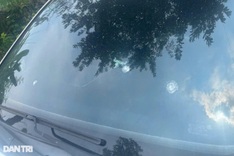More than 410 tourism projects in central Binh Thuan Province have been seriously affected by titanium-exploitation projects, which are polluting coastal areas.
 |
| Tourists hang out on Mui Ne beach in Binh Thuan Province. The province\'s tourism industry has been seriously affected by titanium-exploitation projects. |
According to the provincial Department of Culture, Sports and Tourism, Bac Binh District\'s Hoa Thang Commune is one of several locations where titanium exploitation has damaged tourism projects.
At contiguous areas near Hon Rom – Mui Ne, about 13 enterprises have complained about the waste that is left on beaches by titantium exploiters.
The companies that dig for titanium use sea water to filter the titanium from the sand. But because the sea waters in the area are so calm, the waste is left on shore, driving away tourists.
The pollution is also affecting the attractive Nghe Islet, according to a representative of a tourism company in the province.
In addition, titanium exploiters including Hai Tinh and Tan Quang Cuong companies are working along the coastline of Ham Tan – La Gi, considered a beautiful area attrative to tourists.
Air and water pollution has robbed the area of its beauty, investors have said.
Many tourism investors have withdrawn their projects, even though they have received licenses.
Tran Thi Mai Anh, investor of Tien Phu Tourism Project, complained that the province had focused on tourism as a key economic sector but had granted licenses to many titanium-exploitation projects.
Anh said that her VND20 billion project had to be suspended because her partner had withdrawn its funds. She now wants to sell the project to pay the bank debt.
About 140 of 410 licensed tourism projects are operating in Binh Thuan Province.
Huynh Giac, head of the province\'s Department of Natural Resource and Environment, told Dau Tu newspaper there were 63 tourism projects built in an area of titanium exploration that is part of a larger mineral exploitation plan developed by the Ministry of Natural Resources and Environment.
Nguyen Hong Son, deputy head of the Binh Thuan Tourism Association and owner of Doi Su Resort, said the association had often urged the province not to authorise mineral exploitation near tourism areas, but to no avail.
Nguyen Van Dung, deputy head of the province\'s People\'s Committee, said in October the scheme for titanium exploitation in the province would be completed.
Under the plan, the province would allow tourism projects in areas that have low titanium reserves, and ban mineral exploitation.
For areas rich with titanium, the province will not allow investment or long-term construction in tourism projects.
The province has also asked companies that are exploiting titanium to keep a safe distance from tourism projects and commit to environmental preservation.
Titanium has been exploited in the province for several years, with 2007 being the most active year. Revenue was reported at VND600 million that year, and all of the raw material was exported to China.
"Binh Thuan sees tourism as the key economic sector. So we are trying to reconcile the benefits received by both the tourism and mineral industries," said Nguyen Van Thu, deputy head of Binh Thuan Province People\'s Committee.




















